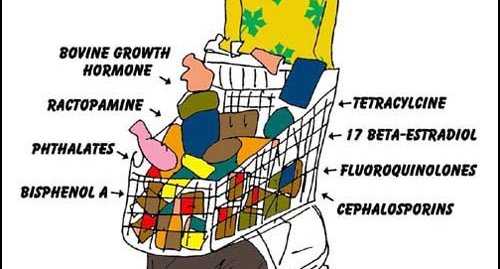It is difficult not to be alarmed.

No less than 396 products with toxic substances or endocrine disruptors are still for sale and end up in our baskets, according to Que Choisir, France’s well renowned Consumers’ Union. Click here and take a look at their list of products and you’ll see toothpastes, soaps, deodorants – for men and women, cosmetics, and more.
Que Choisir has also made available for downloading a small card giving the names of toxic substances found in marketed products. Print it out; keep it in your wallet for when you go shopping: check the labels against the card. Beware what you are buying.

Backing up the fight against these toxic substances, Générations futures, the French environmental NGO, published a study this week on endocrine disruptors (click here for the English version). They took samples of hair from 7 ecologists for testing and found that all 7 showed traces of between 36 and 68 endocrine disruptors, including biphenyl (biphenyl A was banned in French from food containers in 2012) PCBs (Polychlorinated biphenyls, found for example in electric transformers banned from manufacturing since 1987), phtalates (plastics) and pesticides. Generation Futures points out that even if the levels of each individual endocrine disruptor are acceptable, the danger lies in the cocktail effect: a bit of this, a bit of that amounts to dangerous levels of toxicity in the body.
The European Commission’s present definition of endocrine disruptors, published June 2016, is highly disputed, by France and Sweden in particular, and by NGOs, scientists and environmentalists, all of whom consider it too laxest since it bans fewer toxic substances from the market than judged safe.
France’s Environment Minister Ségolène Royal announced this month that the European Commission will publish a new revised definition of endocrine disruptors next Tuesday 28 February. Her strong stand on endocrine disruptors is backed by Anses, the French Agency for Food, Environmental and Occupational Health & Safety, which proposes a different approach to the definition of endocrine disruptors than that of the European Commission, urging for all chemical substances to be categorized, stating their “regret at the absence of a single, harmonised text on categorisation criteria applicable to all chemical substances, irrespective of their uses.”
As the French Environment Minister reaches the end of her mandate, and as the Presidential elections draw near (April 2017), Mme Royal is, in parallel, stepping up her drive to reinforce her “Zéro pesticides” campaign which includes neonicotinoids and phytosanitary products; the campaign is run by the newly formed French Biodiversity Agency – the Agence Française pour la Biodiversité, created August 2016.
Not all French presidential candidates have, to date, shown the same determination to tackle the ongoing problem of toxic substances which affect our health and to confront the powers that be and the manufacturers who are still producing them.
_______________________________________
See also:
Know more about your endocrine disruptors: lists now available online
European Parliament vetoes criteria on endocrine disruptors
Bisphenol A has been recognised as a known endocrine disruptor
More needs to be done on endocrine disruptors
Green Facts: http://www.greenfacts.org/en/index.htm


















